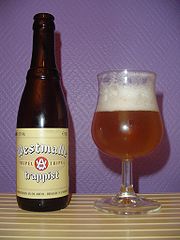
Bottle conditioning
Encyclopedia

Filtered beer
Bright beer is beer in which yeast is no longer in suspension. There are several methods used for clearing yeast from beer, from waiting for the yeast to drop of its own accord to filtering it.-Dropping bright:...
so the final conditioning of the beer takes place in the bottle, or filtered and then reseeded with yeast so that an additional fermentation may take place.
Priming
Priming is the process by which beerBeer
Beer is the world's most widely consumed andprobably oldest alcoholic beverage; it is the third most popular drink overall, after water and tea. It is produced by the brewing and fermentation of sugars, mainly derived from malted cereal grains, most commonly malted barley and malted wheat...
is wholly or partially fermented in the bottle from which it is served. This is done by adding a small amount of wort
Wort (brewing)
Wort, , is the liquid extracted from the mashing process during the brewing of beer or whisky. Wort contains the sugars that will be fermented by the brewing yeast to produce alcohol.- Production :...
or sugar
Sugar
Sugar is a class of edible crystalline carbohydrates, mainly sucrose, lactose, and fructose, characterized by a sweet flavor.Sucrose in its refined form primarily comes from sugar cane and sugar beet...
and sometimes yeast
Yeast
Yeasts are eukaryotic micro-organisms classified in the kingdom Fungi, with 1,500 species currently described estimated to be only 1% of all fungal species. Most reproduce asexually by mitosis, and many do so by an asymmetric division process called budding...
to the bottle before it is sealed. Bottle conditioning is normally done to add carbonation
Carbonation
Carbonation is the process of dissolving carbon dioxide in water. The process usually involves carbon dioxide under high pressure. When the pressure is reduced, the carbon dioxide is released from the solution as small bubbles, which cause the solution to "fizz." This effect is seen in carbonated...
, and does not usually add much alcohol to the beverage.
Carbonation
Bottle conditioned beers are usually carbonated entirely by the natural action of the yeast, as opposed to filtered beers which are carbonated using high pressure gas injection.Storing
Filtered beer tends to have a relatively short shelf lifeShelf life
Shelf life is the length of time that food, drink, medicine, chemicals, and many other perishable items are given before they are considered unsuitable for sale, use, or consumption...
, rarely more than a year, as many compounds in the sterile beverage break down into unpleasant tasting ones. Live yeast inside the bottle acts against these processes, giving the beverage a much longer shelf life. A good bottle conditioned beer can maintain its drinkability for many years, and some can be aged for decades.
Bottle conditioned beers vary in clarity. If the yeast remains in suspension, the drink can appear murky or even chunky. But if the yeast is dense and settles, the drink can be completely transparent with only a thin yeast layer at the bottom. The yeast solids are usually referred to as the sediment or dregs, especially once opened.
Serving
Serving such a beverage involves either decantingDecantation
Decantation is a process for the separation of mixtures. This is achieved by carefully pouring a solution from a container in order to leave the precipitate in the bottom of the original container...
the drink into the serving glass, leaving the sediment behind in the bottle, or pouring all the contents into the glass, including sediment, to be drunk together. Some drinkers like to mix the sediment throughout the beer by tipping or rolling the beer before drinking. This is generally a matter of personal preference, though sometimes the brewer will suggest a preferred method for a particular beer. Yeast sediment has an earthy flavor and is rich in B vitamins. Drinking the sediment has some nutritional benefits, but it does slightly change the flavor and mouthfeel of the beer. The yeast can have a negative effect on some people, causing diarrhea
Diarrhea
Diarrhea , also spelled diarrhoea, is the condition of having three or more loose or liquid bowel movements per day. It is a common cause of death in developing countries and the second most common cause of infant deaths worldwide. The loss of fluids through diarrhea can cause dehydration and...
.
Kräusening
Kräusening is adding active wortWort (brewing)
Wort, , is the liquid extracted from the mashing process during the brewing of beer or whisky. Wort contains the sugars that will be fermented by the brewing yeast to produce alcohol.- Production :...
to beer that is being bottled. The name
Krausen
Kräusen, also spelled "kraeusen" or "krausen", pronounced "KROY-zen", is a beer-brewing term that has two definitions in that context.1. A method to carbonate beer in which wort is added to the fermented/finished beer to carbonate.2...
is German in origin, though the method is used by brewers in various countries - most notably Belgium. Kräusening encourages the yeast to continue fermentation in the bottle. It helps clean up the flavor of the beer by reducing levels of diacetyl
Diacetyl
Diacetyl is a natural byproduct of fermentation. It is a vicinal diketone with the molecular formula C4H6O2...
and acetaldehyde
Acetaldehyde
Acetaldehyde is an organic chemical compound with the formula CH3CHO or MeCHO. It is one of the most important aldehydes, occurring widely in nature and being produced on a large scale industrially. Acetaldehyde occurs naturally in coffee, bread, and ripe fruit, and is produced by plants as part...
. The Old Style brand claims to have returned to the kräusening tradition first used by Gottlieb Heileman in 1902 when he created the beer.

